UNIT 3
ELECTRO CHEMISTRY AND APPLICATIONS
The electrode potential is defined as the Potential difference developed between the metal ions from metal to the solution or from solution to the metal. At equilibrium the potential difference remains constant. The electrode potential of a metal is defined as the direct measure of its tendency to get reduced is called reduction potential, its value is +x volts. Similarly the tendency of an electrode to lose electrons is a measure of its tendency to get oxidized is called oxidation potential, its value is –x volts.
Expression of electrode potential:
Consider the following redox reaction
Mn+ + ne- ↔ M
For such a redox reversible reaction, the free energy change (∆ G) and its equilibrium constant (K) are related as;
∆ G = -RT ln k + RT ln [product]/[Reactant]
∆ G0 + RT ln [product]/[Reactant]………………..(i)
Where
∆ G 0 = standard free energy change.
The above equation is known as Van’t Hoff Isotherm.
The decrease in free energy in the reversible reaction will produce electrical energy i.e.
-∆ G = nEF and ∆ G 0 = -nE0F…………………………(ii)
Where
E = Electrode potential
E0 = Standard electrode potential
F = Faraday (96,500 coulombs)
Comparing equation 1 & 2
-nEF = -nE0F + RT ln [M]/[Mn+]
= -nE0F + Rt ln 1/ [Mn+]
Where, concentration of the metal is unity or
-nEF = -nE0F - RT ln [Mn+]
Dividing the equation by –nF
E= E0 + RT ln [Mn+]/nF
E= E0 + 2.303RT log [Mn+]/nF
E= E0 + 0.0591 log [Mn+]/n ……………(iii)
This equation-3 is known as “Nernst Equation” for electrode potential
Calomel Electrode:
Calomel electrode is particularly very simple to construct, free from surface sensitivity and accurate to use even in a very normal laboratory.

The calomel electrode consists of an inner glass tube and an outer jacket. In the inner glass tube a platinum wire is dipped into mercury which rests on a paste of mercurous chloride, Hg2Cl2 (commercially known as calomel) and mercury. This paste is in contact with KCl present in the outer jacket, through the glass frit plug fixed at the bottom of inner glass tube. The calomel electrode comes in contact with the experimental solution through a frit arranged to the outer jacket. The potential of this electrode depends on the concentration of KCl taken in the outer jacket.
Quinhydrone Electrode:
This is a redox electrode reversible to protons and often replaces the hydrogen electrode. Quinhydrone is a 1:1 molar mixture of quinone and hydroquinone. The electrode consists of a shiny platinum electrode dipped in a acid / base test solution, which is saturated with quinhydrone.
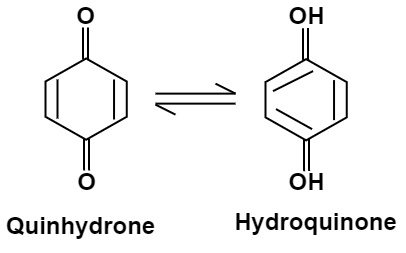
Advantages:
- The quinhydrone electrode is simple to set up and needs no removal of air.
- The reversibility equilibrium is achieved faster than hydrogen gas electrode thereby allowing a quicker measurement.
- PH values of solutions containing reducible substances like Cu2+, Cd2+, unsaturated acids, NO3 - , etc., and catalytic poisons can be measured using quin-hydrone electrode.
Limitations:
- The electrode cannot be used at pH values greater than 8.
- This electrode also fails in the presence of strong oxidizing and reducing agents.
Glass electrode:
Most often used pH electrodes are called glass electrodes and belong to the family of ISE. They are sensitive only to H+ ions. Typical glass electrode is made of glass tube engaged with small glass bubble sensitive to protons. Inside of the electrode is usually filled with buffered solution of chlorides in which silver wire covered with silver chloride is immersed.
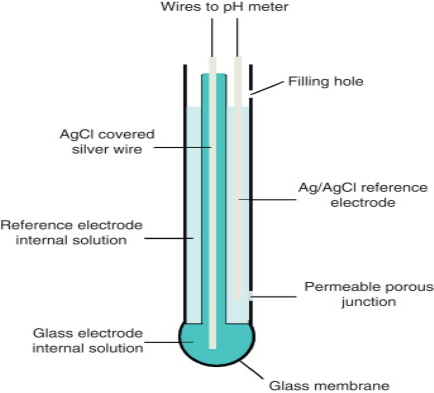
PH of internal solution varies- E.g.; it can be 1.0(0.1M HCl) or 7.0 Active part of the electrode is the glass bubble. While tube has strong and thick walls, bubble is made to be as thin as possible. Surface of the glass is protonated by both internal and external solution till equilibrium is achieved. Both sides of the glass are charged by the adsorbed protons, this charge is responsible for potential difference. This potential in turn is described by the Nernst equation and is directly proportional to the pH difference between solutions on both sides of the glass. The majority of pH electrodes available now a day are combination electrodes that have both glass H+ ion sensitive electrode and reference electrode compartments, conveniently placed in one housing.
Primary (Lithium cell)
It consists of lithium anode with solid electrolyte or liquid electrolyte and solid or liquid cathode. A thin protective insulating film is formed on lithium anode protecting the anode against corrosion as it is conductive to lithium ions but not electrons while water and alcohol never form such film.
Lithium iodide solid cathode cell consists of iodine PVP cathode with 3V voltage. It is highly stable and dependable and hence used in medical source for electronic flash guns of cameras.
Lithium Ion Cells
Anode: Graphite, Carbon compound.
Cathode: Oxide of Lithium
Uses:
Used in Laptops, cellular phones, electronic vehicles.
Secondary Batteries:
Lead-Acid Storage Battery & Lithium Ion Battery:
Lead storage battery is the most common device used to store energy in the portable form. This is also called as lead acid battery. Although the batteries are reliable, which contain acidic material inside that required a proper disposal method after its complete use. These batteries have moderate power density and good time. The battery consists of lead grids on its electrodes. The anodic grid opening is filled with spongy lead while the cathodic grid consists of lead oxide (PbO2).
Charge Chemistry of the battery:
Charge batteries are those batteries which can be recharged after single use. In this type of battery each plate contain negative as well as the positive end. The negative plate is of lead while the positive plate is made up of lead oxide in an electrolyte of approx 4.0M sulphuric acid.
Negative plate reaction:
PbSO4(s) + H+(aq) + 2e– →Pb(s) + HSO4–(aq)
Positive plate reaction:
PbSO4(s) + 2H2O(l) → PbO2(s) + HSO4–(aq) + 3H+(aq) + 2e–
Combining these two reactions, the overall reaction is the reverse of the discharge reaction:
2PbSO4(s) + 2H2O(l) →Pb(s) + PbO2(s) + 2H+(aq) + 2HSO4–(aq)
Discharge Chemistry of the Battery:
The positive and negative plate of the batteries becomes lead sulphate. Due to the loss of sulfuric acid from electrolytes it becomes the water.
Negative plate reaction:
Pb(s) + HSO4–(aq) → PbSO4(s) + H+(aq) + 2e–
Positive plate reaction:
PbO2(s) + HSO4–(aq) + 3H+(aq) + 2e– → PbSO4(s) + 2H2O(l)
Combining these two reactions, one can determine the overall reaction:
Pb(s) + PbO2(s) + 2H+(aq) + 2HSO4–(aq) → 2PbSO4(s) + 2H2O(l)
Electrochemical:
The deterioration of materials by chemical process is called as corrosion. In electrochemical corrosion M→M+ + e- is facilitated by the presence of suitable electron acceptor and some time it is also called as depolarizer. Corrosion can also be viewed as the spontaneous return of metals to their ores, the abandoned amount of energy used that were consumed in the mining, refining into useful objects is dissipated by variety of different routes.
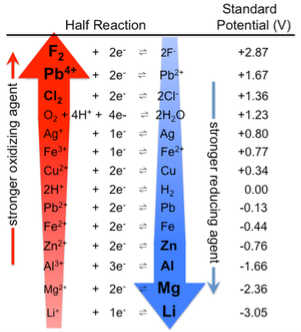
Corrosion Cells and reactions:
The occurrence of oxidation and reduction steps in corrosion results in separation of metal’s location. This can be possible due to the conductive property of metal, so that electrons can flow through metal form anodic to cathodic regions. The water presence plays a major role on transportation.
Fe → Fe2+ + 2e-
The metal is under pressure or is isolated from the air. The metal ions dissolve in the moisture film and e- migrates to another location.
The anodic process is
Fe(s) → Fe2+ (aq) + 2e-
While cathodic steps involve the reduction of oxygen gas
O2 + 2H2O(aq) + 4e- → 4OH-
Or the proton reduction
H+ + e- → ½ H2(g)
Or the reduction of metal ion
M2+ + 2e- → M(s)
Since both the cathodic and anodic steps must take place for corrosion to occur, prevention of either one will stop corrosion. The most obvious strategy is to stop both processes by coating the object with a paint or other protective coating. Even if this is done, there are likely to be places where the coating is broken or does not penetrate, particularly if there are holes or screw threads. A more sophisticated approach is to apply a slight negative charge to the metal, thus making it more difficult for the reaction to take place:
M ⟶ M2+ + 2e−.
Applications:
- The thermal stability of the metal oxide depends on its electropositive nature. As the electropositivity decreases from top to bottom, the thermal stability of the oxide also decreases from top to bottom.
- A more electropositive metal can displace a less electropositive metal from its salt's solution.
- The metal which can provide electrons to ions present in dilute acids for reduction, evolve hydrogen from dilute acids.
This equation is named after the name of scientist who discovered is Walther Nernst. Nernst equation plays a major role in relating the Reduction Potential with the electrode potential, temperature of the chemicals which are undergoing the oxidation or reduction.(Reduction Potential is used to measure the tendency of the chemical species to acquire or loose electron to an electrode.)
Gibbs free energy: Gibbs free energy of the system is the difference of enthalpy of the system with the product of temperature times the entropy of the system.
G=H-TS
 Gibbs free energy of the system is defined in term of the thermodynamics which are state in function. Any change in the Gibbs Free Energy System is directly proportional to the difference of change in the enthalpy of the system with the products of temperature times the entropy of the system.
Gibbs free energy of the system is defined in term of the thermodynamics which are state in function. Any change in the Gibbs Free Energy System is directly proportional to the difference of change in the enthalpy of the system with the products of temperature times the entropy of the system.

 G= H- (TS)
G= H- (TS)
While at constant temperature this reaction transform into:


 G= H-T S
G= H-T S
The Nernst Equation is derived from the Gibbs free energy under standard conditions.
E*=E*reduction-E*oxidation ………..(i)
 G=-nFE ………..(ii)
G=-nFE ………..(ii)
Where,
n=no. Of transferred electrons in the reaction
F= Faraday constant
E=Potential Difference.
While when we see in the standard condition then, equation (ii) becomes
 G*=-nFE* ………….(iii)
G*=-nFE* ………….(iii)
Hence,
Reaction is Spontaneous when E* is positive while non- spontaneous in vice-versa.

 G= G*+RT lnQ ………….(iv)
G= G*+RT lnQ ………….(iv)

 Now, Substituting G=−nFE and G*=−nFE* into Equation 4, we have:
Now, Substituting G=−nFE and G*=−nFE* into Equation 4, we have:
−nFE=−nFEo+RTlnQ …………….(v)
On Dividing both sides of the Equation above by −nF,
E=E*−RTnFlnQ(6) ……….(vi)
Equation (vi) in the form of log10:
E=E*−2.303RT/nF log10Q …….(vii)
At standard temperature T = 298 K, the 2.303RT/F term equals 0.0592 V and Equation
(vii) can be rewritten:
E=E*−0.0592V/n log10Q ……..(viii)

 The equation (viii) clearly indicates that electric potential of cell depends on reaction quotient of reaction. The product formation leads to the increase in the concentration of the products. This tends to decrease the the potential of the cell until it reaches at the stage of equilibrium where, G=0 and G=-nFE Q=K so E=0
The equation (viii) clearly indicates that electric potential of cell depends on reaction quotient of reaction. The product formation leads to the increase in the concentration of the products. This tends to decrease the the potential of the cell until it reaches at the stage of equilibrium where, G=0 and G=-nFE Q=K so E=0
Then on substituting the these values to Nernst Equation we get,
0=E*-RT/nF In K …….(ix)
At room temperature it becomes;
0=E*-0.0592V/n Log10K
LogK=nE*/0.0592V
The above equation clearly indicates the equilibrium constant K is proportional to the standard potential.
Batteries:
The electrical interconnection of two or more electrochemical cells, each of which contain two electrodes and an electrolyte is called a Battery. The condition at which battery is properly working is supply of electric power, the positive terminal is cathode while the negative terminal is anode.
Primary (Lithium cell)
It consists of lithium anode with solid electrolyte or liquid electrolyte and solid or liquid cathode. A thin protective insulating film is formed on lithium anode protecting the anode against corrosion as it is conductive to lithium ions but not electrons while water and alcohol never form such film.
Lithium iodide solid cathode cell consists of iodine PVP cathode with 3V voltage. It is highly stable and dependable and hence used in medical source for electronic flash guns of cameras.
Lithium Ion Cells
Anode: Graphite, Carbon compound.
Cathode: Oxide of Lithium
Uses:
Used in Laptops, cellular phones, electronic vehicles.
Secondary Batteries:
Lead-Acid Storage Battery & Lithium Ion Battery:
Lead storage battery is the most common device used to store energy in the portable form. This is also called as lead acid battery. Although the batteries are reliable, which contain acidic material inside that required a proper disposal method after its complete use. These batteries have moderate power density and good time. The battery consists of lead grids on its electrodes. The anodic grid opening is filled with spongy lead while the cathodic grid consists of lead oxide (PbO2).
Charge Chemistry of the battery:
Charge batteries are those batteries which can be recharged after single use. In this type of battery each plate contain negative as well as the positive end. The negative plate is of lead while the positive plate is made up of lead oxide in an electrolyte of approx 4.0M sulphuric acid.
Negative plate reaction:
PbSO4(s) + H+(aq) + 2e– →Pb(s) + HSO4–(aq)
Positive plate reaction:
PbSO4(s) + 2H2O(l) → PbO2(s) + HSO4–(aq) + 3H+(aq) + 2e–
Combining these two reactions, the overall reaction is the reverse of the discharge reaction:
2PbSO4(s) + 2H2O(l) →Pb(s) + PbO2(s) + 2H+(aq) + 2HSO4–(aq)
Discharge Chemistry of the Battery:
The positive and negative plate of the batteries becomes lead sulphate. Due to the loss of sulfuric acid from electrolytes it becomes the water.
Negative plate reaction:
Pb(s) + HSO4–(aq) → PbSO4(s) + H+(aq) + 2e–
Positive plate reaction:
PbO2(s) + HSO4–(aq) + 3H+(aq) + 2e– → PbSO4(s) + 2H2O(l)
Combining these two reactions, one can determine the overall reaction:
Pb(s) + PbO2(s) + 2H+(aq) + 2HSO4–(aq) → 2PbSO4(s) + 2H2O(l)
Fuel cell is the electrochemical cell that helps in the conversion of chemical energy of a fuel and oxidizing agent into electricity by the help of redox reaction. Fuel cell has to be supplied by an external source of fuel and an oxidant. The hydrogen or any other fuel is oxidized electrochemically inside the fuel cell to produce a potential difference i.e. a voltage capable of producing a working current. The overall chemical reaction in a hydrogen fuel electrochemical cell involves the oxidation of hydrogen by oxygen to produce only water. Hydrogen fuel cells offer an alternative to rechargeable cells and batteries. A fuel cell will produce a potential difference and a workable electric current until one of the reactants is used up.
Hydrogen gas can be used as fuel:
2H2(g) + O2(g) 2H2O(l)
It is an exothermic reaction, releasing lots of heat energy when burnt, remember the 'squeaky pop' lit splint test for hydrogen. The hydrogen - oxygen fuel cell is non-polluting, since only water is produced.
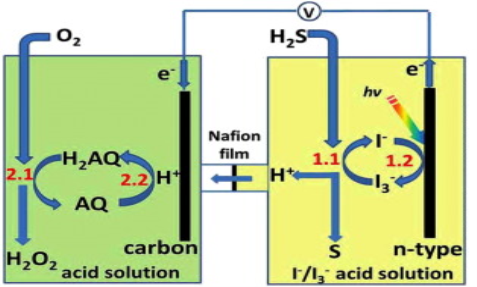
A hydrogen–oxygen fuel cell is a non–polluting clean fuel. Fuel cells do not produce pollutants like carbon monoxide, sulfur dioxide and nitrogen oxides. Cars powered by fuel cells would be quite an environmental advantage in cities, where electric cars are already beginning to be significantly used in developed countries. Fuel cells could replace larger batteries which are not easily recycled and contain highly toxic metal compounds. It would be an ideal fuel on this basis e.g. For motor vehicles, but that's not the only factor to consider. It would be ideal if the hydrogen fuel could be manufactured by electrolysis of water e.g. Using solar cells.
The destruction of metal by chemical or electrochemical attack of environment this process starting at the surface of metal known as corrosion. Corrosion is the two step process that requires three things i.e., a metallic surface, an electrolyte and oxygen. In the process of corrosion a metal atom at surface dissolve into an aqueous solution leaving the metal with excess negatively charged ions.These resultant ions are removed by a suitable electron acceptor. Corrosion can be thought of as the spontaneous return of metals to their ores through the process of oxidation.
Corrosion occurs due to the electrochemical process of oxidation and reduction process. In the corroding solution electrons are released by the metal and that is gained by the elements in the corroding solution. The release of electron from metal is called as the oxidation while vice-versa that is gain of electron by elements is reduction. The regular electron flow in the corrosion reaction can be measured and controlled electronically. This is why controlled electrochemical experimental methods are used to characterize the corrosion properties of metal.
For example,
(i) a thin film of moisture on a metal surface forms the electrolyte for atmospheric corrosion.
When wet concrete is the electrolyte for reinforcing rod corrosion in bridges.
Chemical Corrosion: The reaction of metal with water vapour or gas at high temperature causes the metal to corrode chemically. This is the redox process in which the electron of the metal are passed directly to the substance in the environment. The metal corrodes generally in the metal which is in higher contact with water.
 3Fe + 4H2O Fe3O4 + 4H2
3Fe + 4H2O Fe3O4 + 4H2
 3Fe + 2O2 Fe3O4
3Fe + 2O2 Fe3O4
Electrochemical Corrosion: Corrosion occurs due to the electrochemical process of oxidation and reduction process. In the corroding solution electrons are released by the metal and that is gained by teh elements in the corroding solution. The release of electron from metal is called as the oxidation while vice-versa that is gain of electron by elements is reduction. The regular electron flow in the corrosion reaction can be measured and controlled electronically. This is why controlled electrochemical experimental methods are used to characterize the corrosion properties of metal.
For example,
(ii) a thin film of moisture on a metal surface forms the electrolyte for atmospheric corrosion.
(iii) when wet concrete is the electrolyte for reinforcing rod corrosion in bridges. Although most corrosion takes place in water, corrosion in non-aqueous systems is not unknown.
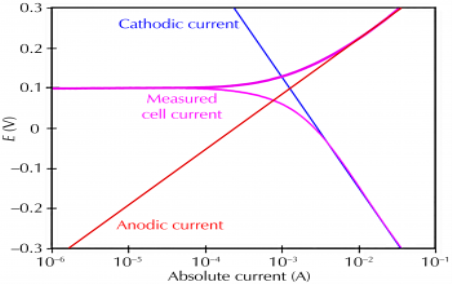
Corrosion process showing the anodic and cathodic component of current
Mechanism of dry corrosion due to O2 gas there are 4 types: -
- Absorption of oxygen molecules on the metal surface
- Dissociation of oxygen atom into metal atom
- Loss of e- by metal atom
- Formation of oxide layer on the metal surface.
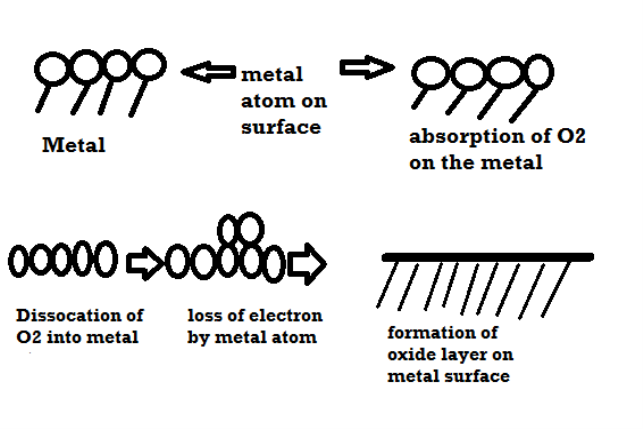
Galvanic series relationships are useful as a guide for selecting metals to be joined, will help the selection of metals having minimal tendency to attract glavinacally, or will indicate the need or degree of protection to be applied to lessen the expected potential interactions. In general, the further apart the materials are in the galvanic series, the higher the risk of galvanic corrosion, which should be prevented by design. Conversely, the farther one metal is from another, the greater the corrosion will be. However, the series does not provide any information on the rate of galvanic corrosion and thus serves as a basic qualitative guide only.
Pitting Corrosion: This type of corrosion occurs at certain conditions, there is a accelerated corrosion in some areas rather than the uniform corrosion over the substance. This condition includes low level of concentration of oxygen or high concentration of chlorides.
Differential Aeration Corrosion:The uneven supply of oxygen to the same metal component leads to the formation of oxygen concentration cells that are called as the differential aeration theory of corrosion. It is the type of electrochemical corrosion that affects the metals such as steel and iron. The less oxygenated part behaves anodic while the more oxygenated part cathodic. Since cathodic reactions involve consumption of oxygen, the more oxygenated part behaves cathodic and less oxygenated pan behaves anodic. The reaction occurs because oppositely charged electrons flow between the smaller anode and larger cathode. Positively charged cations meeting negatively charged anions forming corrosion product and a resulting pit in the metal, otherwise known as pitting corrosion. In a gutter, pipe, tank or similar the anode is just below the waterline. This is where the oxidation occurs, corrosion product forms and a pit develops weakening the metal.
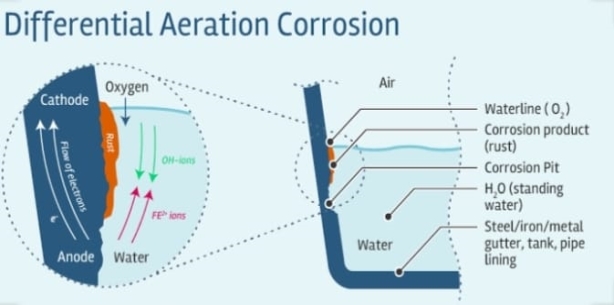
(i) Nature of metal
Position of metal in galvanic series.
If position is higher in galvanic series then it corrode faster
While for 2 metal the difference between them shows the corrosion ratio.
(ii) Potential Difference
If the difference at the electrode potential between two metal is high then the rate of corrosion would be also high while vice versa for lesser difference.
(iii) Purity of metal
Corrosion never took place in pure metals. While if metal itself has a impurity then galvanic cell set up easily which intend increases the rate of corrosion.
(iv) Relative areas of cathode and anode parts
Rate of corrosion is directly depends on the area of cathode and inversely depends on the area of anode. If the area of cathode is larger then there is more demand of electrons while in the smaller anode area the corrosion took place very fast.
(v) Nature of corrosion Product
Metal oxide film is formed on the surface of metal by corrosion due to oxygen. The formed film would be stable, unstable, volatile.
(vi) Temperature
At high temperature the rate of corrosion increases as because there is a consistent increase in the ionization and mobility difference rate while in some cases rate of corrosion decreases at high temperature as the solubility of O2 gas increases.
(vii) Presence of moisture
The rate of corrosion decreases in dry while increases in presence of moisture. Moisture act as the solvent for setting up of electrochemical corrosion.
(viii) Effect of pH
Rate of corrosion is high at acidic pH due to the evolution of H2 gas at cathode.
(ix) Concentration of electrolytes
This is also called as the Oxygen concentration cell. The rate of corrosion would be directly depends on the supply of oxygen on air.
(x) Over Voltage
The difference between the actual value and theoretical value of decomposition potential of electrode.
This is the technique used to control the corrosion on the surface of metal by formation of cathode layer on an electrochemical cell. There are 2 types of cathodic protections:
(i) Sacrificial Anodic Protection
(ii) Impressed Current Cathodic Protection
It is a chemical compound that decreases the corrosion rate of a material when added to a liquid or gas. Chemical substance which is present in the corrosion system at a suitable concentration decreases the corrosion rate, without significantly changing the concentration of any corrosive agent.
The nature of the corrosive inhibitor depends on –
(i) The material being protected
(ii) The corrosive agent to be neutralized
Principle:
Electroplating is a method in which coating metal is coated on the base metal on the basis ofelectrolysis principle.
Processes:
- The article to be electroplated is cleaned well.
- There is a non-conducting tank which containing coating metal salts.
- The article is connected to the negative terminal of DC source which act as a cathode.
- Anode is a coating metal.
- After adjusting suitable PH and density on the base metal, then this method is started.
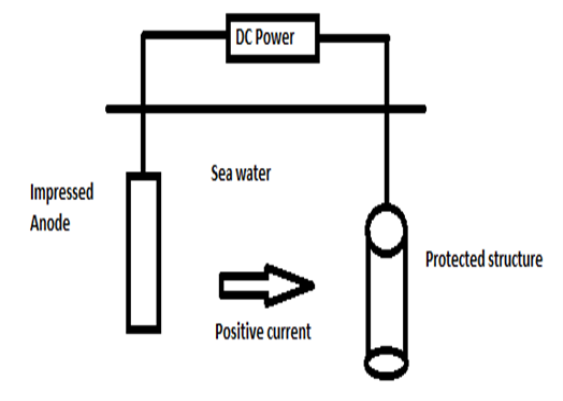
Metal ions in a solution migrate towards the article and get deposit on the base metal in the form of coating layer.
- Cr + 3e- - Cr (if cr plating)
- Ag+ + Ag - Ag (if Ag plating)
- Ni + + 2e- - Ni (if Ni plating)
At anode (Coatingmetal)
- Cr - Cr + + 3e –
- Ag - Ag + + e-
- Ni - Ni + + 2e-
Advantages: -
- Electroplating can be done on the article of any shape
- This is strong coating
Application: -
- Corrosion protection method
- Decoration
- It is also applicable on the non – metallic surface
- Electroplating is done on the many parts of machines.
- Coating metals: -Cu,Ni,Cr, Ag, etc.
- Base metals: - Fe (steel)non-metallic surface like glass.